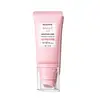What's inside
What's inside
 Key Ingredients
Key Ingredients

 Benefits
Benefits

 Concerns
Concerns

No concerns
 Ingredients Side-by-side
Ingredients Side-by-side

Water
Skin ConditioningZinc Oxide
Cosmetic ColorantTitanium Dioxide
Cosmetic ColorantAscorbic Acid
AntioxidantNiacinamide
SmoothingHyaluronic Acid
HumectantPropanediol
SolventDiisopropyl Adipate
EmollientLecithin
EmollientAcrylic Acid/Acrylamidomethyl Propane Sulfonic Acid Copolymer
Dimethylmethoxy Chromanol
AntioxidantGlyceryl Caprylate
EmollientXanthan Gum
EmulsifyingC12-15 Alkyl Benzoate
AntimicrobialCaprylic/Capric Triglyceride
MaskingCaprylyl Methicone
Skin ConditioningWater, Zinc Oxide, Titanium Dioxide, Ascorbic Acid, Niacinamide, Hyaluronic Acid, Propanediol, Diisopropyl Adipate, Lecithin, Acrylic Acid/Acrylamidomethyl Propane Sulfonic Acid Copolymer, Dimethylmethoxy Chromanol, Glyceryl Caprylate, Xanthan Gum, C12-15 Alkyl Benzoate, Caprylic/Capric Triglyceride, Caprylyl Methicone
Water
Skin ConditioningButylene Glycol
HumectantHomosalate
Skin ConditioningIsoamyl P-Methoxycinnamate
UV AbsorberMethylene Bis-Benzotriazolyl Tetramethylbutylphenol
UV FilterSilica
AbrasiveBis-Ethylhexyloxyphenol Methoxyphenyl Triazine
Skin ConditioningDiethylhexyl Butamido Triazone
UV AbsorberDibutyl Adipate
EmollientCaprylyl Methicone
Skin ConditioningNiacinamide
SmoothingButyloctyl Salicylate
Skin ConditioningDiethylamino Hydroxybenzoyl Hexyl Benzoate
UV FilterEthylhexyl Triazone
UV AbsorberCI 77891
Cosmetic ColorantAlpha-Arbutin
AntioxidantTranexamic Acid
AstringentTocopherol
AntioxidantDecyl Glucoside
CleansingPhenoxyethanol
PreservativeAcrylates/C10-30 Alkyl Acrylate Crosspolymer
Emulsion StabilisingPotassium Cetyl Phosphate
EmulsifyingTromethamine
BufferingChlorphenesin
AntimicrobialPEG-240/Hdi Copolymer Bis-Decyltetradeceth-20 Ether
StabilisingDisodium EDTA
Ethylhexylglycerin
Skin ConditioningPropylene Glycol
HumectantPhytic Acid
Xanthan Gum
EmulsifyingSodium Hydroxide
BufferingPotassium Laurate
EmulsifyingWater, Butylene Glycol, Homosalate, Isoamyl P-Methoxycinnamate, Methylene Bis-Benzotriazolyl Tetramethylbutylphenol, Silica, Bis-Ethylhexyloxyphenol Methoxyphenyl Triazine, Diethylhexyl Butamido Triazone, Dibutyl Adipate, Caprylyl Methicone, Niacinamide, Butyloctyl Salicylate, Diethylamino Hydroxybenzoyl Hexyl Benzoate, Ethylhexyl Triazone, CI 77891, Alpha-Arbutin, Tranexamic Acid, Tocopherol, Decyl Glucoside, Phenoxyethanol, Acrylates/C10-30 Alkyl Acrylate Crosspolymer, Potassium Cetyl Phosphate, Tromethamine, Chlorphenesin, PEG-240/Hdi Copolymer Bis-Decyltetradeceth-20 Ether, Disodium EDTA, Ethylhexylglycerin, Propylene Glycol, Phytic Acid, Xanthan Gum, Sodium Hydroxide, Potassium Laurate
 Reviews
Reviews

Ingredients Explained
These ingredients are found in both products.
Ingredients higher up in an ingredient list are typically present in a larger amount.
Caprylyl Methicone is a type of silicone.
It helps soften and soothe the skin by creating a thin film on top. This film helps trap moisture, keeping your skin hydrated.
Niacinamide is a multitasking form of vitamin B3 that strengthens the skin barrier, reduces pores and dark spots, regulates oil, and improves signs of aging.
And the best part? It's gentle and well-tolerated by most skin types, including sensitive and reactive skin.
You might have heard of "niacin flush", or the reddening of skin that causes itchiness. Niacinamide has not been found to cause this.
In very rare cases, some individuals may not be able to tolerate niacinamide at all or experience an allergic reaction to it.
If you are experiencing flaking, irritation, and dryness with this ingredient, be sure to double check all your products as this ingredient can be found in all categories of skincare.
When incorporating niacinamide into your routine, look out for concentration amounts. Typically, 5% niacinamide provides benefits such as fading dark spots. However, if you have sensitive skin, it is better to begin with a smaller concentration.
When you apply niacinamide to your skin, your body converts it into nicotinamide adenine dinucleotide (NAD). NAD is an essential coenzyme that is already found in your cells as "fuel" and powers countless biological processes.
In your skin, NAD helps repair cell damage, produce new healthy cells, support collagen production, strengthen the skin barrier, and fight environmental stressors (like UV and pollution).
Our natural NAD levels start to decline with age, leading to slower skin repair, visible aging, and a weaker skin barrier. By providing your skin niacinamide, you're recharging your skin's NAD levels. This leads to stronger, healthier, and younger looking skin.
Another name for vitamin B3 is nicotinamide. This vitamin is water-soluble and our bodies don't store it. We obtain Vitamin B3 from either food or skincare. Meat, fish, wheat, yeast, and leafy greens contain vitamin B3.
The type of niacinamide used in skincare is synthetically created.
Learn more about NiacinamideWater. It's the most common cosmetic ingredient of all. You'll usually see it at the top of ingredient lists, meaning that it makes up the largest part of the product.
So why is it so popular? Water most often acts as a solvent - this means that it helps dissolve other ingredients into the formulation.
You'll also recognize water as that liquid we all need to stay alive. If you see this, drink a glass of water. Stay hydrated!
Learn more about WaterXanthan gum is used as a stabilizer and thickener within cosmetic products. It helps give products a sticky, thick feeling - preventing them from being too runny.
On the technical side of things, xanthan gum is a polysaccharide - a combination consisting of multiple sugar molecules bonded together.
Xanthan gum is a pretty common and great ingredient. It is a natural, non-toxic, non-irritating ingredient that is also commonly used in food products.
Learn more about Xanthan Gum